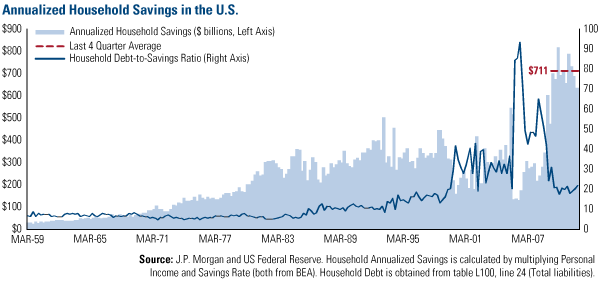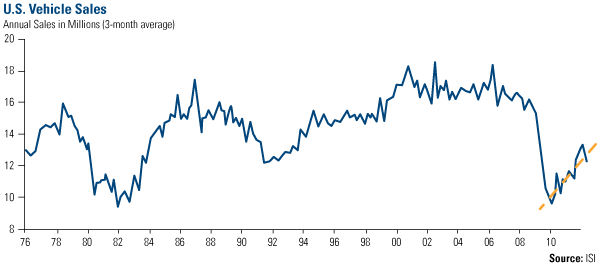Don’t Miss Your Chance to Catch a Bull Market
Many people missed the market’s enormous appreciation during the latest equity bull market because they were late to the game or chose to sit on the sidelines. If you’re one of those people on the sidelines who has been debating whether to get your feet wet in today’s market—now could be your chance. Citigroup says there’s roughly a 90% chance markets could move higher over the next six months—and a 97% chance over the next year—according to historical data. On average, the market bounces 8.9% the following six months and 17.3% the following year. Words: 1294
So say Frank Holmes and John Derrick (www.usfunds.com) in edited excerpts from an article* which Lorimer Wilson, editor of www.munKNEE.com (It’s all about Money!), has further edited ([ ]), abridged (…) and reformatted below for the sake of clarity and brevity to ensure a fast and easy read. Please note that this paragraph must be included in any article re-posting to avoid copyright infringement. Holmes and Derrick go on to say:
The sideline is a crowded place these days as investors have been reluctant to fully embrace equities [but such should be seriously reconsidered given the following:]
Household Savings UP/Debt-to-savings Ratio is DOWN
Household savings for the past 12 months…[were] the highest level ever recorded in dollar terms. You can see from the chart that’s roughly double the amount of savings recorded following the Tech Bubble. In fact, household debt-to-savings ratios are currently at levels so low, they’ve not been seen since the mid-1990s.

History Says Market Outlook is UP
If you’re one of the people on the sidelines who has been debating whether to get your feet wet in today’s market—now could be your chance…J.P. Morgan research says the [recent] seven-consecutive-week losing streak was an extremely rare occurrence during bull markets, only occurring once before in March 1980 and that year the market rallied 15 percent over the next three months.
Historically, summer’s arrival has been good for the market. J.P. Morgan analysts [also] researched the S&P 500’s performance during the June-August period over the last 111 years. They discovered that markets have risen 3 percent on average during this period, with pretty high frequency of up-years (roughly 60 percent). During bull markets, which we believe we’re currently in, the S&P 500 averaged 5 percent with up-years 77 percent of the time…
Investor Sentiment is LOW
One reason we think the market will rise during the second half of 2011 is that sentiment has grown pervasively negative in recent weeks. The American Association of Individual Investors (AAII) survey of investor sentiment, a popular contrarian indicator, showed 77 percent of individuals were bearish in June, one of the lowest readings since the beginning of this bull market in March 2009, according to J.P. Morgan.
Panic/Euphoria Model is DOWN
Citigroup research also showed the pendulum has swung too far toward negativity. Their Panic/Euphoria Model, a proprietary combination of nine facets of investor beliefs and fund manager actions, gauges the mood toward the market. Overly bullish territory (Euphoria) generally signals a market correction is on its way, while a recovery arrives when sentiment is overly pessimistic (Panic). Market sentiment fell into a “panic” at the end of June, which is a good sign for investors.

Dow Theory Projects Optimism
It’s likely that ardent followers of Dow Theory can hardly contain their excitement. This technical indicator for the Dow Jones Industrial Average (DJIA) is on the verge of confirming the market’s bull status. Marketwatch’s Mark Hulbert wrote yesterday that a bull market would be confirmed by Dow Theory if the DJIA closes above its April high of 12,810.54… [Go here to get the current DJIA number.]
Global Economy Improving
If this technical data doesn’t convince you, maybe improvement in the global economy will.
a) Greece: We received our first dose of clarity on the Greece sovereign debt issue and it looks like calamity has been averted.
b) China: The Chinese government, which has been tightening policies to keep the country’s economy from overheating, announced its third interest rate hike this year. This likely is the end of China’s tightening measures and its economy should react positively.
c) U.S.: [While it is] true today’s jobs report [in the U.S.] was dismal and second-quarter 2011 U.S. GDP growth is expected to come in [at only] around 2 percent for the second-straight quarter there is also positive momentum building for the U.S. economy. Manufacturing strength is the foundation of a growing economy, and currently both the services and manufacturing Purchasing Managers Index (PMI) remain above the benchmark 50 level… indicating expansion.
One bright spot is the auto industry, our trusty indicator of the global economy’s fortitude…A supply shortage and slowdown in sales as a result of the Japanese earthquake caused many car manufacturers to initiate their annual plant shutdowns early this year. The shutdown time is used to perform maintenance on facilities and restock supply. Automakers such as Ford and General Motors have already completed their shutdowns and are “starting their engines” for a strong second half.
U.S. Auto Production UP
U.S. auto production is forecasted to be up 16 percent in July over the previous month and overall production during the third quarter of 2011 is expected to be up 86 percent on a quarter-over-quarter basis. ISI says this would likely raise America’s real GDP by 1 percent.
Who will buy all these cars? Chinese and Americans and, despite the tightening measures mentioned above, Chinese citizens are expected to purchase 18.5 million vehicles this year, which would be about a 3 percent increase from 2010. ISI says owning a car remains the “#1 most desired consumer durable” in China and estimates the country could reach sales of 30 million per year by 2030.
At home in the U.S., vehicles sales have been on an uptrend since early 2010. The chart shows current levels are still well below the highs of the mid-2000s but are comparable to the early 1990s—just about the time the U.S. economy was beginning to speed up.

Negative Influences on the Market Exist
The biggest question mark surrounding the direction of the market right now is geopolitical. How the debt ceiling issue is resolved and how companies digest new regulations could decide whether the bull market gets caged. J.P. Morgan-Chase CEO Jamie Dimon passionately told the Federal Reserve last month that some of the floated ideas could spell “suffocation through regulation” for the U.S. economy. Dimon questioned whether anyone had “bothered to study the cumulative effect” of all the new regulations. PIMCO CEO Bill Gross has echoed similar statements. We share many of these concerns but feel the fundamentals of U.S. economic growth can power through these regulatory hurdles.
Conclusion
Long-term investors must remember that it’s time in the market, not timing the market…Investors who catch the bull and participate could see gains over the next few months.
*http://www.usfunds.com/investor-resources/investor-alert/
Related Articles:
- These Indicators Suggest S&P 500 Overvalued In Excess of 40%! https://munknee.com/2011/07/these-indicators-suggest-sp-500-overvalued-in-excess-of-40/
- Market Crash Will Hit By Christmas 2011! Here’s Why https://munknee.com/2011/07/the-sp-500-is-worth-only-910-get-out-or-lose-big/
- S&P 500 Likely To Top Out at 1400 – 1500 & Then Topple to 400! Here’s Why https://munknee.com/2011/02/uncanny-relationship-with-nikkei-1929-crash-suggests-sp-500-about-to-top-out-and-then-tumble/
- P/E Ratio of S&P 500 at 9 Month Low! Is It Time to Buy? https://munknee.com/2011/06/pe-ratio-of-sp-500-at-9-month-low-is-it-time-to-buy/
- Will a Black Swan Event Cause the S&P 500 to Drop by 40%? https://munknee.com/2011/06/will-a-black-swan-event-cause-the-sp-500-to-drop-by-40/
- Stock Market is Due for a 15-20% Correction – Here’s Why https://munknee.com/2011/06/stock-market-is-due-for-a-15-20-correction-heres-why/
- A Violent Correction Is Coming For the S&P 500! Here’s Why https://munknee.com/2011/06/a-violent-correction-is-coming-for-the-sp-500-heres-why/
- Why a Major Stock Market Correction is Imminent https://munknee.com/2011/05/why-and-how-best-to-play-a-major-stock-market-correction-is-imminent/
- S&P 500 is 45% Overvalued According to Reversion to Mean Analysis! https://munknee.com/2011/01/these-2-historical-charts-show-how-high-then-how-low-the-sp-500-might-go/
- How Mean Will the S&P 500′s Future Regression to Trend Be? https://munknee.com/2011/01/how-mean-will-the-sp-500s-future-regression-to-trend-be/
- Surprise! Limited Downside Risk Exists In S&P 500 https://munknee.com/2011/06/surprise-limited-downside-risk-exists-in-sp-500/
*http://dshort.com/articles/valuation-indicator-overview.html
Editor’s Note:
- The above article consists of reformatted edited excerpts from the original for the sake of brevity, clarity and to ensure a fast and easy read. The author’s views and conclusions are unaltered.
- Permission to reprint in whole or in part is gladly granted, provided full credit is given as per paragraph 2 above.
 munKNEE.com Your Key to Making Money
munKNEE.com Your Key to Making Money